Northstar 1114, 1108, 1109 User Manual
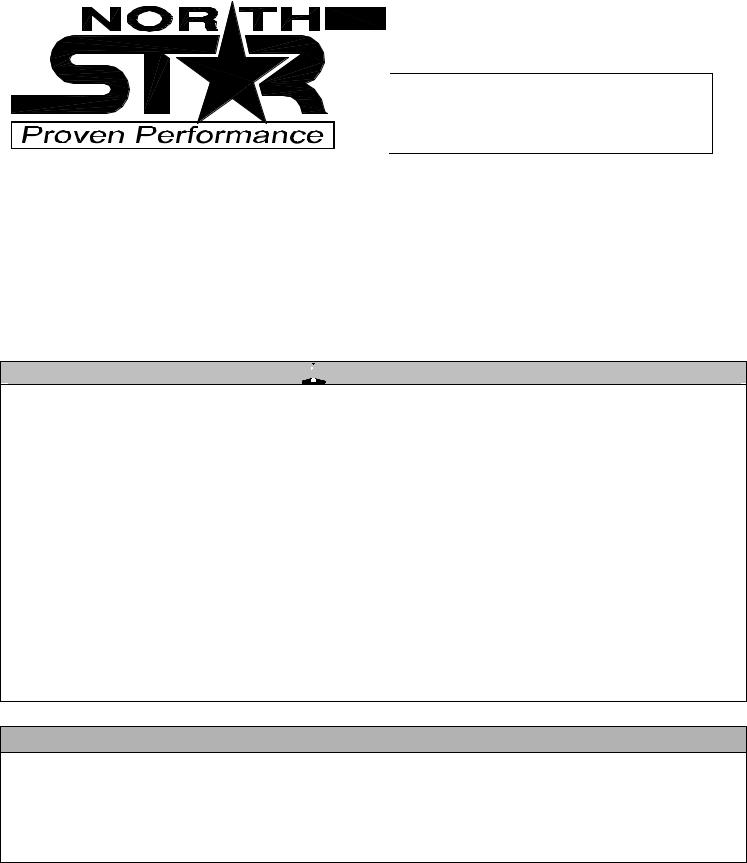
M1108L
|
ITEM NUMBER: 1108, 1109, 1114 |
® |
SERIAL NUMBER: _____________________ |
Owner’s Manual
Instructions for Assembly, Testing, Operation, Servicing, & Storage
22, 30, 37-Ton Log Splitters: Outdoor hydraulic powered machine that splits wood logs.
 WARNING
WARNING
READ and UNDERSTAND this manual completely before using log splitter.
All operators of this equipment must read and completely understand all safety information, operating instructions, maintenance and storage instructions. Failure to properly operate and maintain the log splitter could result in serious injury to the operator and bystanders from moving parts that can crush or cut, flying objects, burns, fire or explosion, escaping high pressure hydraulic fluid, or carbon monoxide poisoning in particular, be aware of the following hazards.
Crush and Cut Hazards
Moving parts can crush and cut hands and fingers. Keep hands clear of endplate, wedge, logs, and log strippers while splitting.
High Pressure Hydraulic Fluid Hazards
High fluid pressures and temperatures are developed in hydraulic log splitters. Hydraulic fluid escaping through even a pin-size hole opening can puncture skin and cause severe blood poisoning. Inspect hydraulic system regularly for possible leaks. Never check for leaks with your hand while the system is pressurized. Seek medical attention immediately if injured by escaping fluid.
Fire Hazards
•If your log splitter is intended for use near an ignitable forest, brush, or grassy covered land, the engine exhaust should be equipped with a spark arrestor. See the “Specifications” section of this manual to determine if your splitter already has a spark arrestor. If not equipped, call NorthStar Product Support for ordering information.
•Keep a fire extinguisher with you that is rated for ordinary combustibles and flammable liquids.
STOP!
ADD OIL TO ENGINE BEFORE USING: Engine is shipped without oil. DO NOT start log splitter without first adding oil. ADD HYDRAULIC OIL: Your log splitter was shipped without hydraulic oil. Refer to Periodic Maintenance section of this
manual for instructions on filling the hydraulic reservoir
INSPECT COMPONENTS: Closely inspect to make sure no components are missing or damaged.
See Initial Unpacking & Set-up for instructions and for whom to contact to report missing or damaged parts.
Any Questions, Comments, Problems or Parts Orders
Call NorthStar Product Support 1-800-270-0810
1
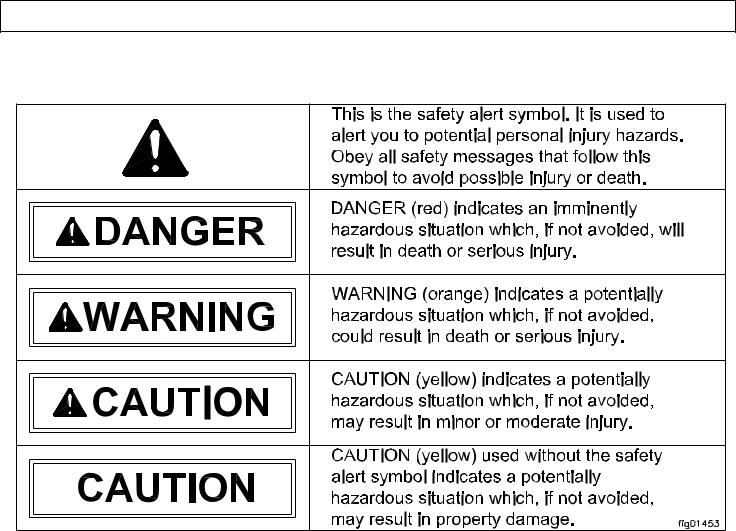
Hazard Signal Word Definitions
2

Table of Contents
About Your Log Splitter........................................................................................................... |
4 |
Safety Label Locations............................................................................................................. |
5 |
Machine Components Identification ........................................................................................ |
7 |
Initial Set-up ............................................................................................................................. |
8 |
Optional 4-Way Wedge Wings ................................................................................................ |
10 |
Moving & Towing to the Job Site ............................................................................................ |
11 |
Before Each Use: |
|
Step One: Inspection/Maintenance................................................................................. |
14 |
Step Two: Refueling....................................................................................................... |
16 |
Step Three: Work site Selection & Set-up .................................................................... |
17 |
Splitting Operation ................................................................................................................... |
19 |
Storage...................................................................................................................................... |
24 |
Periodic Maintenance ............................................................................................................... |
25 |
Troubleshooting........................................................................................................................ |
26 |
Specifications ........................................................................................................................... |
27 |
Parts Breakdown – Exploded View.......................................................................................... |
28 |
Summary of Important Safety Information for Operation ....................................................... |
30 |
Assembly Instructions .............................................................................................................. |
35 |
3
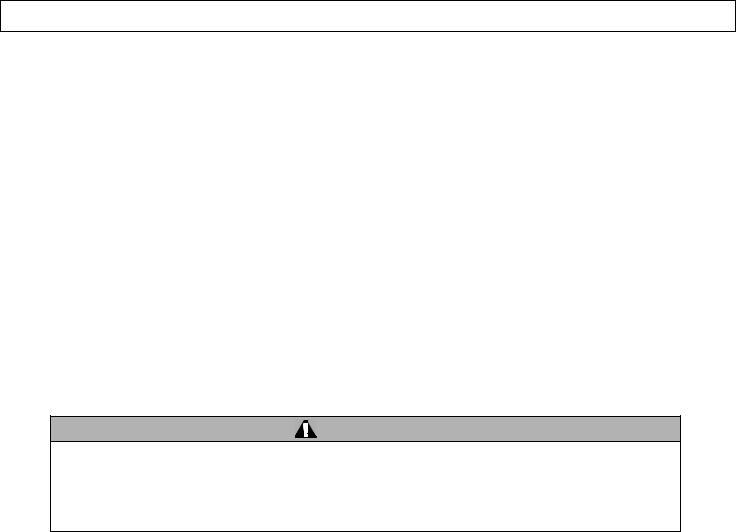
About Your Log Splitter
Thank you for purchasing your NorthStar log splitter!
About Your Log Splitter:
This log splitter is a machine designed to split wood logs using a hydraulically powered moving wedge. The log splitter’s gasoline engine is used to pressurize the hydraulic system.
This log splitter is designed to split logs lengthwise with the grain only.
Your splitter can be used in either a vertical or horizontal splitting position:
•When the splitter is set up to operate in the horizontal splitting position, a log is placed on the horizontal beam and the wedge moves horizontally into the end of the log to split it.
•When the splitter is set up to operate in the vertical splitting position, the log is placed on the endplate, upright on its end, and the wedge moves down into the top of the log to split it.
The horizontal splitting position is used for lighter logs that can be easily loaded onto the beam. The vertical splitting position is used for heavier logs that are difficult to load onto the beam.
The technical specifications for your log splitter are provided in the Specifications section of this manual.
WARNING
This log splitter uses a high-pressure hydraulic system to generate a very strong splitting force.
Read the manual completely before using the machine to understand how to safely operate and maintain it.
Follow all safety precautions presented throughout this manual. A summary of important safety information can be found at the end of this manual.
Contact NorthStar Product Support at 1-800-270-0810 for any questions about the appropriate use of this log splitter and/or optional accessories.
Warranty Registration:
Please fill out and submit the warranty registration card so that we have your contact information for any future product literature or replacement parts you may need.
Attention: All Rental Companies and Private Owners who loan this equipment to others!
All persons to whom you rent/loan the log splitter must have access to and read this manual. Keep this owner’s manual with the splitter at all times and advise all persons who will operate the machine to read it. You must provide instruction on how to safely operate the splitter and remain available to answer any questions a renter/borrower might have.
4
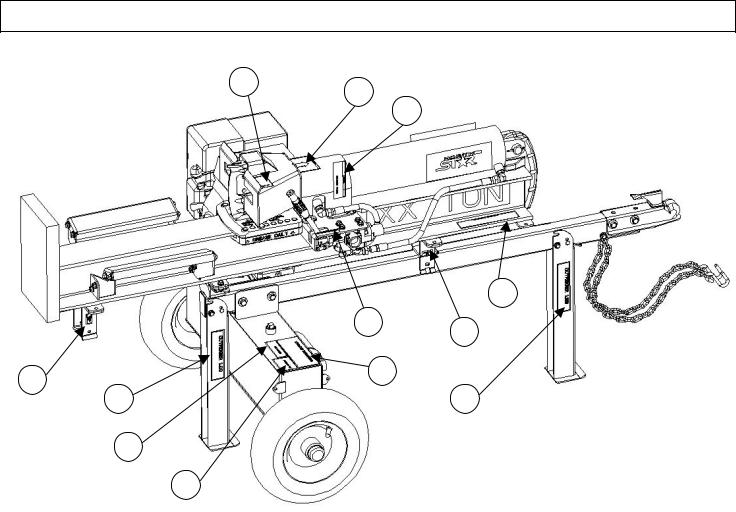
Safety Label Locations
11
9
4
5
8
7
2
10
6 |
6 |
3
Fig 02403
1
Reference # |
Part # |
Description |
1 |
39259 |
Warning Decal |
2 |
777887 |
Splitter Operating Instruction Decal |
3 |
777890 |
Fire Hazard Warning Decal |
4 |
777891 |
Hydraulic Fluid Warning Decal |
5 |
777892 |
Moving/Towing Decal |
6 |
778593 |
Outrigger Leg Decal |
7 |
778597 |
Horizontal Lock Decal |
8 |
778609 |
Control Decal |
9 |
778610 |
Log Splitter Warning Decal |
10 |
778714 |
Vertical Lock Decal |
11 |
778717 |
Log Stripper Decal |
Always make sure safety labels are in good condition. If a safety label is missing or not legible, order new labels or unsafe operation could result.
5
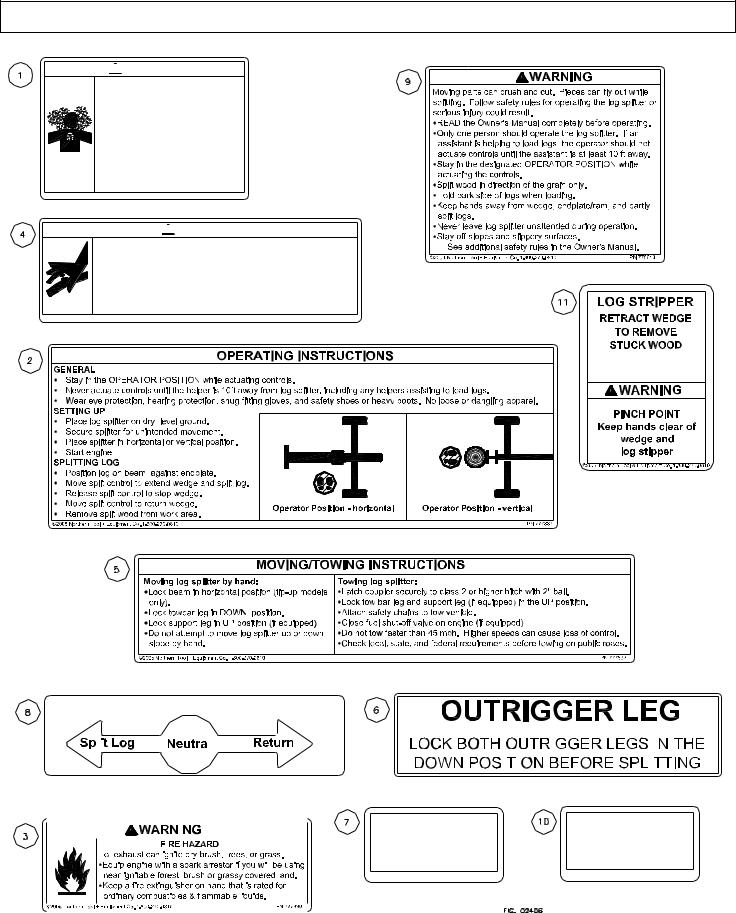
Safety Label Locations

 WARNING
WARNING
POISONOUS GAS
This product's use gives off carbon monoxide, an odorless gas that can kill you.
ONLY use outdoors and away from air intakes.
NEVER use inside homes, garages, or sheds. EVEN IF you run a fan or open doors and windows.
See product manual for more details.
©2005 Northern Tool + Equipment Co. 1-800-270-0810 |
PN 39259 |

 WARNING
WARNING
ESCAPING HIGH PRESSURE HYDRAULIC FLUID HAZARD
High fluid pressures and temperatures are developed in the hydraulic system. Hydraulic fluid escaping through even a pin-size hole opening can puncture skin and cause blood poisoning. Inspect hydraulic system regularly for leaks
Never check for leaks with your hand while system is pressurized. Seek medical attention immediately if injured by escaping fluid.
©2005 Northern Tool + Equipment Co. 1-800-270-0810 |
PN 777891 |
SPLIT CONTROL LEVER OPERATION
|
|
|
|
|
|
|
|
|
|
|
|
|
|
|
|
|
|
|
|
|
|
|
|
|
|
|
|
|
|
|
|
|
|
|
|
|
|
|
|
|
|
|
|
|
|
|
|
|
|
|
|
|
|
|
|
|
|
|
|
|
|
|
|
|
|
|
|
|
|
|
|
|
|
|
|
|
|
|
|
|
|
|
|
|
|
|
|
|
|
|
|
|
|
|
|
|
|
|
|
|
|
|
|
|
|
|
|
|
|
|
|
|
|
HORIZONTAL |
VERTICAL |
||||
|
|
|
|
|
|
|
|
|
|
|
|
|
|
|
|
|
|
|
|
|
|
|
|
||||||
|
|
|
|
|
|
|
|
|
|
|
|
|
|
|
|
|
|
|
|
|
|
|
|
||||||
|
|
|
|
|
|
|
|
|
|
|
|
|
|
|
|
|
|
|
|
|
|
|
|
||||||
|
|
|
|
|
|
|
|
|
|
|
|
|
|
|
|||||||||||||||
|
|
|
|
|
|
|
|
|
|
|
|
|
|
|
|
|
|
|
|
|
|
|
|
||||||
|
|
|
|
|
|
|
|
|
|
|
|
|
|
|
|
|
|
|
|
|
|
|
|
LOCK |
LOCK |
||||
|
|
|
|
|
|
|
|
|
|
|
|
|
|
|
|
|
|
|
|
|
|
|
|
||||||
|
|
|
|
|
|
|
|
|
|
|
|
|
|
|
|
|
|
|
|
|
|
|
|
||||||
|
|
|
|
|
|
|
|
|
|
|
|
|
|
|
|
|
|
|
|
|
|
|
|
||||||
|
|
|
|
|
|
|
|
|
|
|
|
|
|
|
|
|
|
|
|
|
|
|
|
PN 778597 |
PN 778714 |
||||
|
|
|
|
|
|
|
|
|
|
|
|
|
|
|
|
|
|
|
|
|
|
|
|
||||||
|
|
|
|
|
|
|
|
|
|
|
|
|
|
|
|
|
|
|
|
|
|
|
|
||||||
|
|
|
|
|
|
|
|
|
|
|
|
|
|
|
|
|
|
|
|
|
|
|
|
||||||
|
|
|
|
|
|
|
|
|
|
|
|
|
|
|
|
|
|
|
|
|
|
|
|
|
|
|
|
|
|
|
|
|
|
|
|
|
|
|
|
|
|
|
|
|
|
|
|
|
|
|
|
|
|
|
|
|
|
|
|
|
|
|
|
|
|
|
|
|
|
|
|
|
|
|
|
|
|
|
|
|
|
|
|
|
|
|
|
|
|
|
|
|
|
|
|
|
|
|
|
|
|
|
|
|
|
|
|
|
|
|
|
|
|
|
|
|
|
|
|
|
|
|
|
|
|
|
|
|
|
|
|
|
|
|
|
|
|
|
|
|
|
|
|
|
|
|
|
|
|
|
|
|
|
|
|
|
|
|
|
|
|
|
|
|
|
|
|
|
|
|
|
|
|
|
|
|
|
|
|
6
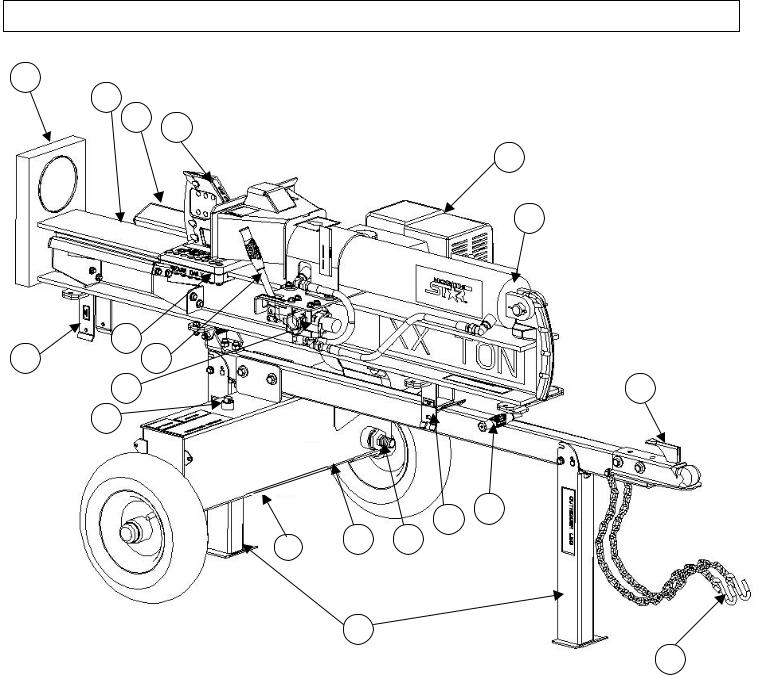
Machine Component Identification
11
10
9
8
13
4
|
19 |
18 |
6 |
7 |
1 |
5
3
2
20 |
14 |
15 |
|
|
Fig 02407 |
12 |
|
17
Ref # |
Description |
1 |
2” Ball Coupler |
2 |
Horizontal Lock |
3 |
Lifting Handle |
4 |
Cylinder |
5 |
Hydraulic Oil Dipstick |
6 |
Split Control Lever |
7 |
Control Valve |
8 |
Wedge |
9 |
Log Cradle |
10 |
Beam |
Ref # |
Description |
11 |
Endplate |
12 |
Outrigger Legs |
13 |
Engine |
14 |
Hydraulic Tank |
15 |
Suction Strainer |
17 |
Safety Chains |
18 |
Vertical Lock |
19 |
Grease Zerks |
20 |
Drain Plug |
7
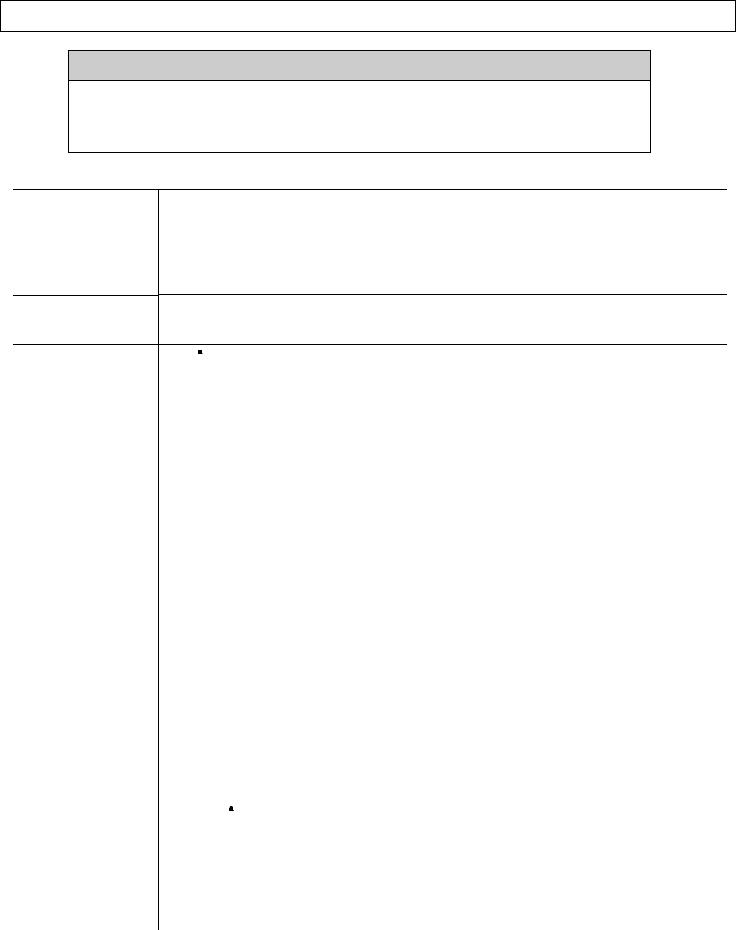
Initial Set-Up
IMPORTANT!
Engine is shipped without oil. DO NOT start the engine before adding oil.
See Assembly Instructions section of this manual to assemble the log splitter before set-up.
Step One:
Inspect Log
Splitter
Components.
Step Two:
Add Oil to Engine
Step Three:
Add Hydraulic Oil to Reservoir
Closely inspect all log splitter components.
(See Machine Components section of this manual for diagram of components.)
•If you have missing components, contact Product Support at 1-800-270-0810.
•If you have damaged components, contact the Freight Company that delivered the unit and file a claim.
Add oil to the engine. Using a funnel. Add SAE 10W-30 oil up to the FULL mark on the dipstick. (See engine Owner’s Manual for oil capacity and location of fill cap.)
 WARNING: High fluid pressures and temperatures are developed in hydraulic log splitters. Hydraulic fluid escaping through a pin hole sized opening can burn or puncture skin, resulting in wounds that could cause blood poisoning, infection, disability, gangrene, amputation, or death. Therefore, the following instructions should be heeded at all times when inspecting or servicing the hydraulic components of the log splitter.
WARNING: High fluid pressures and temperatures are developed in hydraulic log splitters. Hydraulic fluid escaping through a pin hole sized opening can burn or puncture skin, resulting in wounds that could cause blood poisoning, infection, disability, gangrene, amputation, or death. Therefore, the following instructions should be heeded at all times when inspecting or servicing the hydraulic components of the log splitter.
•NEVER check for leaks with your hand. Leaks can be located by holding a piece of cardboard or wood (at least two feet long) with your hand at one end and passing the other end over the suspected area (wear eye protection). Look for discoloration of the cardboard or wood.
•NEVER adjust the pressure of the pump or valve.
•If injured by escaping fluid, no matter how small the wound is, see a doctor at once. A typical injection injury may be a small wound that does not look serious. However, severe infection or reaction can result if proper medical treatment is not administered immediately by a doctor who is familiar with injection injuries.
1.Remove hydraulic oil dipstick.
2.Refer to the Specifications section for approximate hydraulic oil capacity.
3.Fill reservoir with 10 wt AW32, ASLE H-150, or ISO 32 oil. Use a funnel
4.Replace hydraulic oil dipstick.
5.Start engine and use control valve handle to extend and retract wedge 5 (five) times to remove air from the high pressure lines.
6.With wedge retracted, check oil level again. Fill if necessary.

 WARNING: NEVER remove the hydraulic oil fill cap when the engine is running or hot. Hot oil can escape causing severe burns. Allow log splitter to cool completely before removing hydraulic oil fill cap.
WARNING: NEVER remove the hydraulic oil fill cap when the engine is running or hot. Hot oil can escape causing severe burns. Allow log splitter to cool completely before removing hydraulic oil fill cap.
Note: If the log splitter will be run for long periods of time in outdoor temperatures above 70F, we recommend changing the hydraulic oil to DEXTRON III.
8
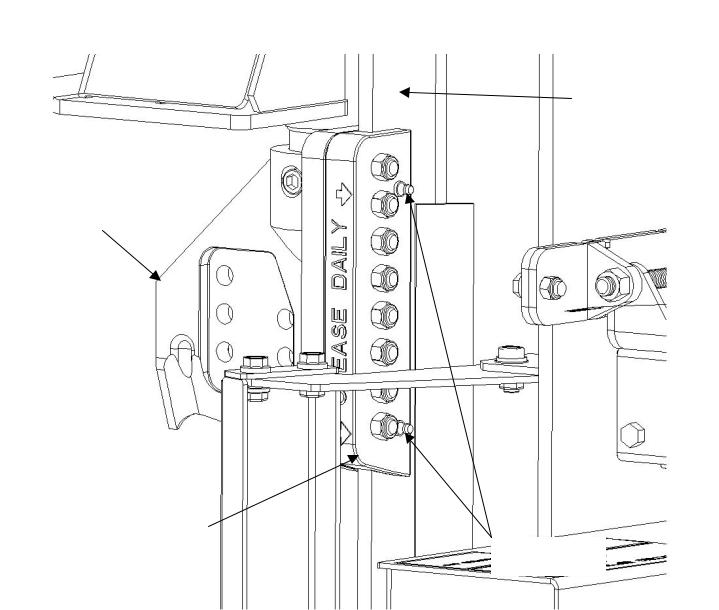
|
|
Initial Set-Up |
||
|
Step Four: |
Pump grease into grease zerks found under each keeper. This will help prevent |
||
|
Lubricate Keepers |
wear between the keepers and beam. |
||
|
|
|
|
|
|
|
|
BEAM |
|
|
|
|
|
|
WEDGE
KEEPER
GREASE ZERK
9

Optional 4-Way Wedge Wings
4-Way Wedge
Wings
Wing Assembly
1.Unbox and identify components
2.Insert Nylon nuts into hex cutouts in wing
3.Position wings into proper locations on the wedge and bolt into position using supplied bolts
4.Tighten the bolts with a 3/8” hex wrench
|
|
|
Exploded View |
|
Assembled View |
||||
|
|
|
|
|
|
|
|
|
|
|
|
|
|
|
|
|
|
|
|
|
|
|
|
|
|
|
|
|
|
|
|
|
|
|
|
|
|
|
|
|
|
|
|
|
|
|
|
|
|
|
|
|
|
|
|
|
|
|
|
|
|
|
|
|
|
|
|
|
|
•4-Way Wings create additional pinch points when the wedge is moving forward or backwards. Keep hands clear of the wedge, wedge wings, and the log while the wedge is moving. When the log is caught on the wedge do not use the auto-return feature. Retract wedge manually, paying close attention so the log does not hit the engine or control valve.
•Pay particular attention to stringy wood, such as elm, because it becomes lodged on the wedge easily.
To order call: Northern Tool + Equipment at 1-800-556-7885
Item # 1143
10

Moving and Towing to the Job Site
WARNING
The log splitter is heavy. It can crush and cause serious injury if it rolls out of control or tips over.
Follow the instructions below for safely moving and towing the log splitter.
Moving the log splitter:
1. Place in |
Make sure the log splitter is locked in the horizontal position with hitch pin |
Horizontal |
before moving. |
position |
NEVER move log splitter when it is in vertical configuration because it will be |
|
|
|
unstable and could tip. |
2.Engine off. IMPORTANT: Make sure log splitter engine is off.
|
|
Never move the log splitter with its engine running. |
3. |
Fuel valve off |
Turn fuel valve off to prevent carburetor flooding and reduce the chance of fuel |
|
(if equipped) |
leakage. Refer to Engine owner’s manual for fuel valve location. |
4. |
Lock: |
Lock the front outrigger leg in the “DOWN” position and the rear support leg |
|
• Front |
in the “UP” position before you move the log splitter. |
|
outrigger leg |
|
|
DOWN |
|
•Rear outrigger leg UP
|
|
Lock front |
Lock rear |
|
|
outrigger leg in the |
|
|
Fig 02409 |
outrigger leg in |
|
|
down position |
||
|
|
the up position |
|
|
|
|
|
|
Move log splitter by hand either directly to chosen work site or to vehicle |
||
5. Move log splitter |
|||
to work site or |
hitch for towing. |
|
|
tow hitch |
(See Before Each Use: Step Three: instructions on selecting a work site) |
||
|
Important Safety Instructions: |
|
|
•Hills. Do not move the log splitter up or down hills by hand—use a towing vehicle.
•No riding. Never allow anyone to sit or ride on the log splitter.
•No cargo. Never transport cargo or wood on the log splitter.
11
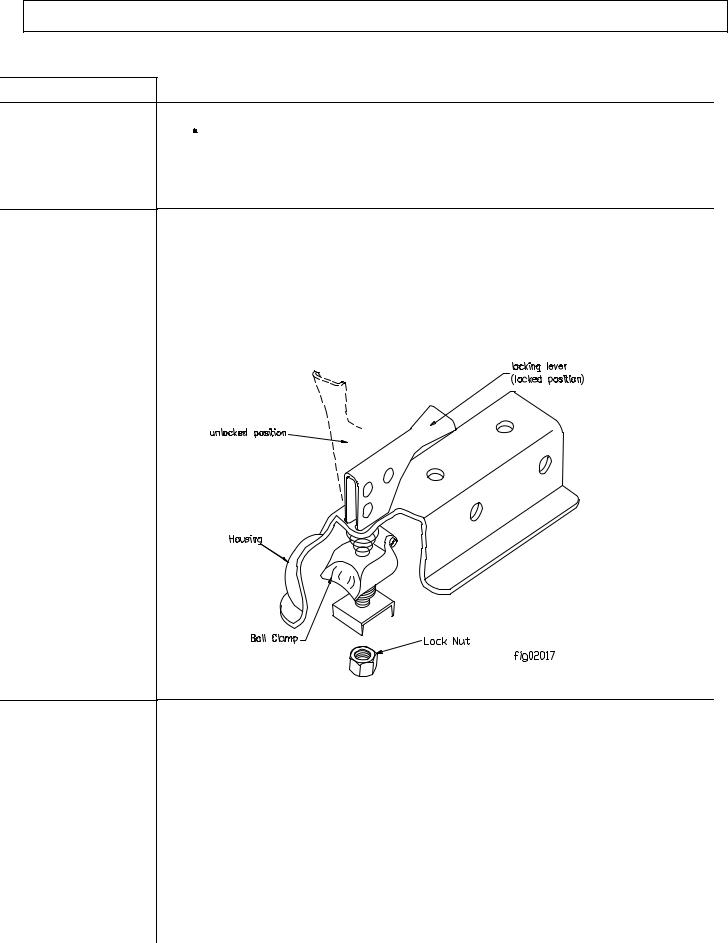
Moving and Towing to the Job Site
Towing:
1.Read instructions
2.Check tires
3.Attach to hitch (2” ball)
4.Attach safety chains
Review towing safety instructions in your vehicle manual.
Make sure tires are fully inflated and in good repair.

 WARNING:
WARNING:
•Do not over-inflate tires. Serious injury can occur if tire explodes.
•When seating a bead after repair, do not exceed 30 PSI. Pressures higher than 30 PSI can cause the tire and wheel to rupture and explode.
Attach log splitter to vehicle hitch
1. Attach log splitter’s coupler to a class 2 or higher hitch with 2” ball (only).
2.Adjust coupler to ball by raising locking lever and turning lock nut with fingers.
3.Proper adjustment is obtained when coupler is as tight as possible on ball and locking lever can still be opened and closed.
4.Lock lever closed to secure the attachment. An optional locking pin or padlock may be inserted in the locking lever hole for extra security.
Attach safety chains.
1.Two safety chains must be used while towing.
2.Cross safety chains under the coupler allowing only enough slack for vehicle turns.
12
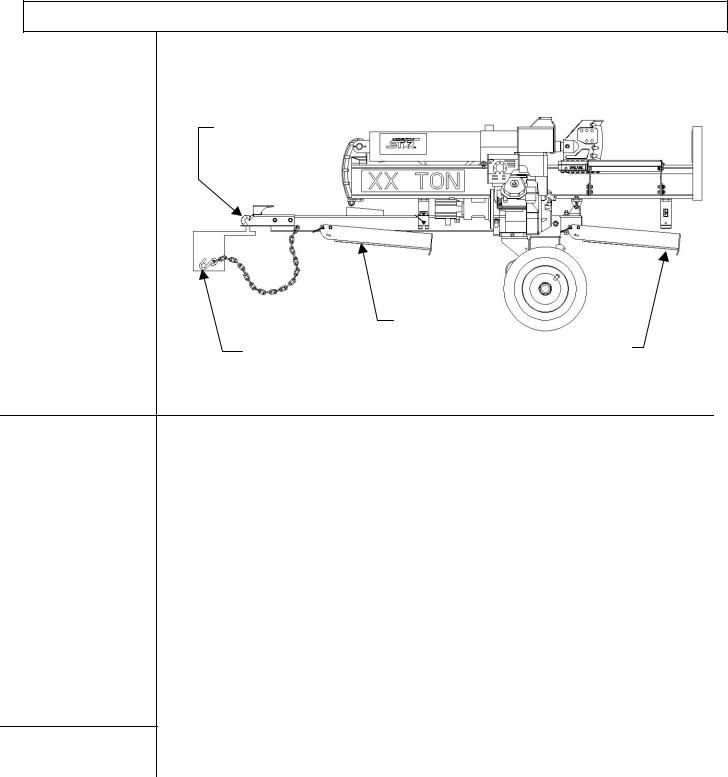
Moving and Towing to the Job Site
5.Put front outrigger leg UP
6.Tow to desired location
7.Lock front outrigger leg down & unhitch
Move the front outrigger leg to the “UP” position and lock. (Both outrigger legs must remain in the up position during towing.)
Fig 02410
Attach coupler to class 2 or higher hitch with 2” ball. Latch Securely.
|
Lock front |
|
|
outrigger leg in the |
Lock rear |
Hook both safety |
up position |
|
chains to the towing |
|
outrigger leg in the |
vehicle |
|
up position |
Tow log splitter carefully to desired work site.
(See Before Each Use section on selecting an appropriate work site)
Important safety instructions:
•Added length. Be aware of the added length of the splitter.
•Speed limit. Never tow this log splitter over 45 mph. Faster speeds may result in loss of control.
•Rough terrain. Drive slowly and take extra caution when traveling over rough terrain.
•On public roads. If towing on a public road, make sure to comply with all local, state, and federal towing requirements. It is the sole responsibility of the purchaser to obtain licensing, trailer lights, safety chains or signage, as needed to comply.
•Unattended. Turn off the towing vehicle before leaving the splitter unattended.
•Under the influence. Never tow or operate this splitter while under the influence of alcohol, drugs, or medication.
Lock front outrigger leg in the DOWN position and disconnect from vehicle.
NEVER operate log splitter while it is attached to the vehicle.
13
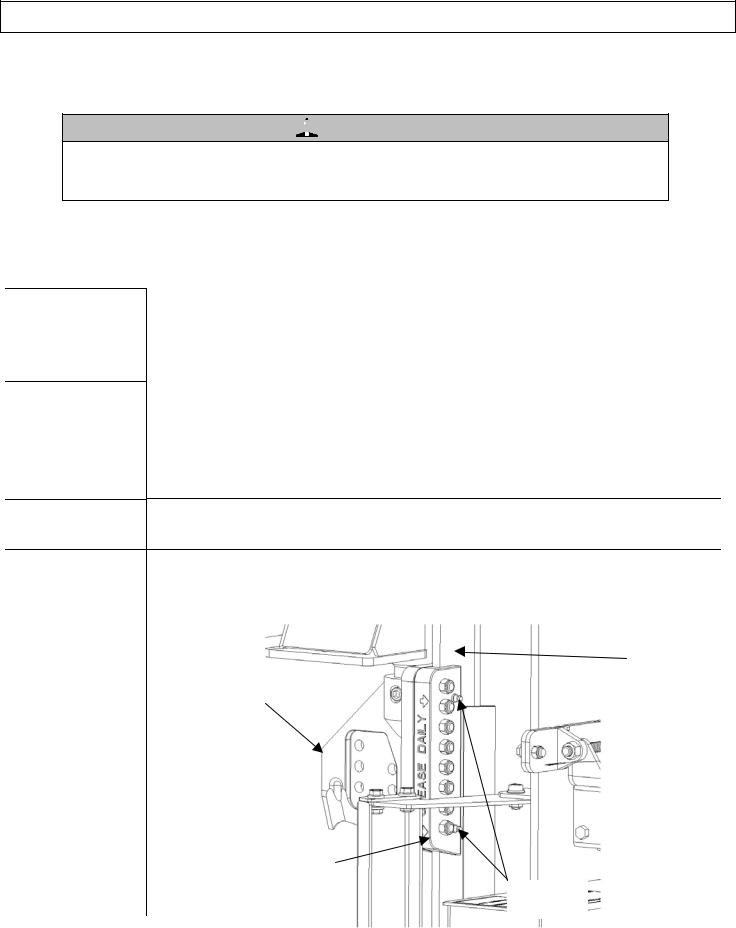
Before Each Use-Inspection / Maintenance
Step One: Inspect and maintain log splitter before each use
If the log splitter has been used previously, it must be inspected and maintained BEFORE EACH SUBSEQUENT USE.
 WARNING
WARNING
ALWAYS shut off the engine, disconnect the spark plug, and relieve system pressure before inspecting, cleaning, adjusting, or repairing the splitter. Relieve system pressure by moving Split Control Lever back and forth several times.
IMPORTANT:
If a part needs replacement, only use parts that meet the manufacturer’s specifications. Replacement parts that do not meet specifications may result in a safety hazard or poor operation of the log splitter.
1.Engine off / relieve pressure
2.Remove debris
3.Fuel tank / lines
4.Mechanical parts
Perform all inspections/repairs with the engine off and hydraulic system pressure relieved.
1.Make sure engine is off and cool.
2.Disconnect the spark plug
3.Relieve all hydraulic system pressure by moving the Split Control Lever back and forth several times.
Remove debris from engine, muffler, and moving parts.
1.Engine debris. Debris on a hot engine can be a fire hazard. Clean debris and chaff from engine cylinder head, cylinder head fins, blower housing rotating screen, and muffler areas. Avoid contact with hot muffler.
2.Other debris. Debris on moving parts can cause excess wear. Clear debris from the slide beam, wedge, and endplate.
Check fuel tank and fuel lines for leaks.
Any fuel leak is a fire hazard. Fix any fuel leaks before starting engine.
Check to be sure that all nuts and bolts are tight to make sure the log splitter is in safe working condition.
Apply grease to grease zerks.
BEAM
WEDGE
Fig 02408
KEEPER
GREASE
ZERKS
14
